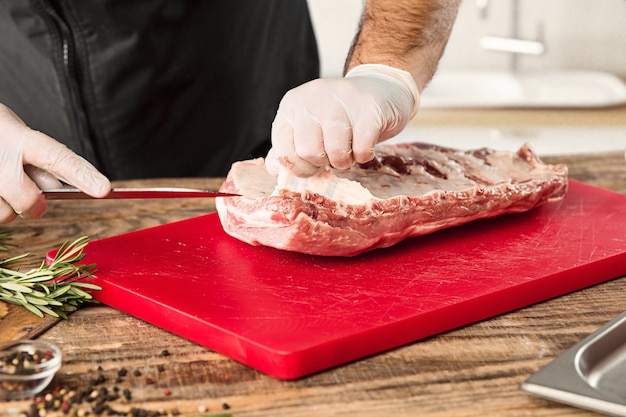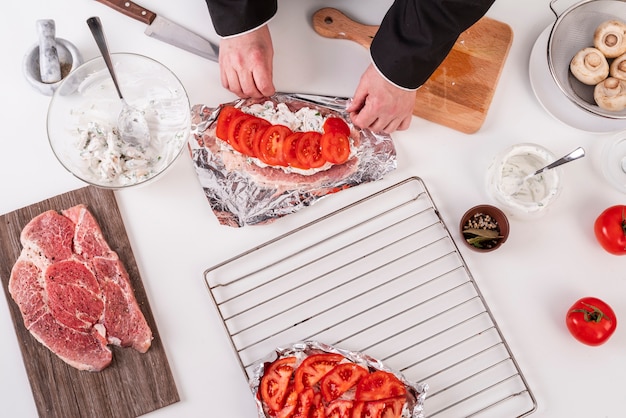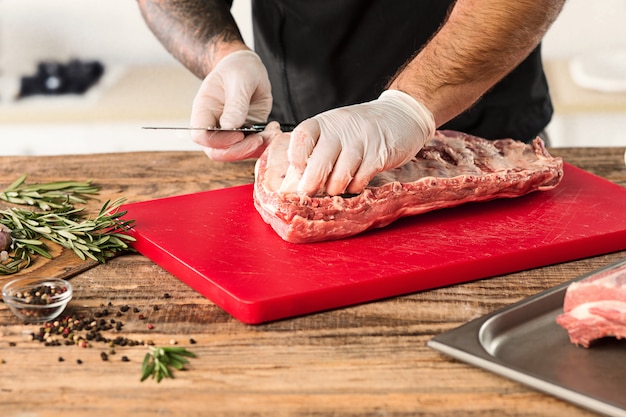Let's be honest, there's something about a perfectly cooked steak that just screams "indulgence." That juicy, flavorful bite, the satisfying sear, the way it melts in your mouth – it's pure culinary bliss. But achieving that steak nirvana isn't always easy. It's taken me years of trial and error, experimenting in my own kitchen, to figure out the secrets to a consistently tender, flavorful steak. Now, I'm ready to share my hard-earned knowledge with you.
(Part 1) choosing the right cut: The Foundation of Your steak masterpiece

Think of choosing the right steak cut like picking the perfect ingredients for a dish. You wouldn't try to make a soufflé with flour and water, would you? It's the same with steak. Each cut has its unique characteristics, and knowing which one to choose is crucial to achieving your desired result.
A Guide to the Most Popular steak cuts:
- Sirloin: A classic for a reason! Sirloin offers a balanced flavor profile and a satisfying chew. It's great for grilling, pan-frying, or even roasting, and holds up well to various cooking methods.
- Rib-eye: Ah, the rib-eye! This is the steak that screams "indulgent." It's known for its generous marbling, which means it's packed with flavor and incredibly juicy. You'll want to cook this one medium-rare to medium, as it can get tough if overdone.
- filet mignon: The ultimate tender steak. This cut is lean and delicate, perfect for special occasions. Be warned: it's also the most expensive, so treat yourself wisely.
- new york strip: A thick, substantial cut, often described as a "steakhouse classic." The generous marbling and thick profile make it ideal for searing and grilling. It's a versatile steak that can be cooked in many ways.
- flank steak: This is the tough-but-flavorful option. Think of it as the adventurous steak lover's choice. It's best for marinating and grilling, as the tenderizing effect of the marinade and high heat transforms the texture into a juicy, tender delight.
Getting the Best Quality: Choosing Your Meat Wisely
Once you've picked your cut, the next step is selecting the best possible quality. Look for steaks that are bright red and have good marbling – those little streaks of fat that are the key to a flavorful, juicy steak. Avoid anything that looks dull or dry. If you're unsure, don't hesitate to ask your butcher for advice. They're the experts and can help you find the perfect piece of meat for your needs.
(Part 2) Prepping Your Steak for Success: Setting the Stage for a Stellar Steak

Alright, you've got your steak, now it's time to get it ready for the heat. This is about more than just seasoning, folks. Think of this prep phase as the foundation of your steak masterpiece.
The Art of Patting Dry: A Crucial First Step
Before you even think about seasoning, pat your steak dry with paper towels. This might seem like a small detail, but it's essential to prevent the steak from steaming in the pan, ensuring a crisp, flavorful sear.
Seasoning is King: A Simple Yet Powerful Step
Now, it's time to flavor your steak. Salt and pepper are the absolute basics, and honestly, you can't go wrong with just those two. But don't be afraid to get creative! I love adding a pinch of garlic powder for an extra punch, a sprinkle of smoked paprika for a smoky depth, or even a bit of chili powder for a kick. It's all about your personal preference.
Let It Rest: Bringing Your Steak to Room Temperature
The final step before cooking is to let your steak rest at room temperature for about 30 minutes. This might seem counterintuitive, but it allows the meat to come to room temperature, ensuring a more even cook throughout.
(Part 3) The cooking techniques: Bringing Your Steak to Life

Now, we're getting to the heart of the matter – the actual cooking. You've got your chosen cut, it's prepped to perfection, and you're ready to transform it into a culinary triumph.
Pan-Searing: A Classic Technique for a Beautiful Crust
This is my go-to method. It's simple, quick, and delivers a beautiful, crispy crust that seals in the juices and adds an incredible depth of flavor.
1. Get Your Pan Sizzling: The Key to a perfect sear
Heat a heavy-bottomed pan over high heat. We're talking scorching hot here, the kind of heat that sizzles when you add a drop of water to the pan. This intense heat is what creates that irresistible sear.
2. Adding Oil: The Foundation for Flavor
Add a tablespoon or two of oil to the pan. I prefer a neutral oil like vegetable or canola, but feel free to experiment with others.
3. Searing Perfection: The Art of a Crisp Crust
Place your steak in the pan and let it cook for 2-3 minutes per side, without touching it. This is essential for getting a beautiful sear. Don't be tempted to move it around; let the steak cook undisturbed for the full time.
4. Reduce the Heat: Cooking Through to Perfection
After searing both sides, reduce the heat to medium and continue cooking for another 3-5 minutes per side for a medium-rare steak. Use a meat thermometer to check the internal temperature – we'll talk more about that later.
5. Resting is Essential: Allowing the Juices to Redistribute
Remove the steak from the pan and let it rest for 5-10 minutes before slicing and serving. This allows the juices to redistribute throughout the steak, resulting in a juicier, more tender bite.
Grilling: A Summertime Staple for a Smoky Flavor
Grilling is a classic summertime favorite, and for good reason. It imparts a smoky flavor that's hard to resist.
1. Pre-Heating is Key: Ensuring Even Cooking
Start by preheating your grill to medium-high heat. This is crucial for getting a good sear and achieving even cooking.
2. Direct and Indirect Heat: Controlling Your Heat
You can cook the steak directly over the heat source for a faster cook, or use indirect heat for a more even cook.
3. Grill Marks: A Sign of a Well-Cooked Steak
For a classic grill-marked steak, place the steak directly over the heat source and let it cook for 2-3 minutes per side. You'll get beautiful, evenly distributed grill marks, a telltale sign of a well-cooked steak.
4. Rotating for Even Cooking: Perfecting the Sear
After you've seared each side, rotate the steak 90 degrees and continue cooking for another minute or two. This creates those beautiful crosshatch grill marks, a visual treat that adds to the satisfaction of cooking a great steak.
5. Watching the Temperature: Ensuring Doneness
Keep an eye on the internal temperature of the steak using a meat thermometer. Once it reaches your desired doneness, remove it from the grill and let it rest for 5-10 minutes before slicing and serving.
(Part 4) Mastering Different Doneness Levels: Finding Your Steak Sweet Spot
Getting your steak to the right doneness is a matter of personal preference, but it's essential for achieving a satisfying, flavorful experience.
Understanding the Levels of Doneness: A Guide to Steak Preferences
Doneness is measured by the internal temperature of the steak, and it can range from rare to well-done. Each level has its unique characteristics:
| Doneness | Internal Temperature (°F) | Internal Temperature (°C) | Description |
|---|---|---|---|
| Rare | 125-130 | 52-54 | Cool red center, very soft texture. |
| Medium-Rare | 130-135 | 54-57 | Warm red center, slightly springy texture. |
| Medium | 135-140 | 57-60 | Pink center, firm texture. |
| Medium-Well | 140-145 | 60-63 | Slightly pink center, very firm texture. |
| Well-Done | 145-150 | 63-65 | No pink, fully cooked, dry texture. |
Using a Meat Thermometer: Your Steak's Best Friend
A meat thermometer is your trusty sidekick in the steak-cooking world. It takes the guesswork out of knowing when your steak is done, ensuring consistent results every time. Simply insert the thermometer into the thickest part of the steak and check the temperature, leaving it in for about 10 seconds to get an accurate reading.
How to Judge Doneness Without a Thermometer: A Handy Trick
If you don't have a meat thermometer, you can use the "touch test" to estimate doneness. It's not as precise as a thermometer, but it can be helpful:
- Rare: The steak will feel very soft and squishy. The center will be cool and red.
- Medium-Rare: The steak will feel slightly springy and the center will be warm and red.
- Medium: The steak will feel firm and the center will be pink.
- Medium-Well: The steak will feel very firm and the center will be slightly pink.
- Well-Done: The steak will feel extremely firm and the center will be gray.
(Part 5) Perfecting Your steak sauce: Elevating the Flavor to New Heights
You've cooked your steak to perfection, but what about that finishing touch? A good steak sauce can take your culinary masterpiece to a whole new level of deliciousness.
The Importance of Sauce: A Symphony of Flavors
Think of sauce as the orchestra accompanying your steak. It adds complexity, richness, and a whole new dimension of flavor.
A Classic Steak Sauce Recipe: A Simple, Delicious Recipe
- 1/2 cup ketchup
- 1/4 cup Worcestershire sauce
- 2 tablespoons brown sugar
- 1 tablespoon Dijon mustard
- 1 teaspoon garlic powder
- 1/2 teaspoon onion powder
- 1/4 teaspoon black pepper
How to Make It: Simple Steps for a Flavorful Sauce
1. Combine all the ingredients in a small saucepan.
2. Bring to a simmer over medium heat.
3. Simmer for 5-10 minutes, or until the sauce has thickened slightly.
4. Remove from heat and let cool slightly before serving.
Store-Bought vs. Homemade: A Matter of Preference
While store-bought steak sauces are convenient, there's something special about making your own. You can customize the flavors to your liking, and it's surprisingly easy to do. Experiment with different ingredients, like herbs, spices, or even a splash of red wine for added complexity.
(Part 6) The Ultimate steak sides: Completing Your Culinary Symphony
No steak is complete without a stellar side dish to complement its rich flavor. Here are a few of my favorite pairings:
- Roasted Vegetables: A classic for a reason. Roasting vegetables brings out their natural sweetness and creates a caramelized texture that contrasts beautifully with the steak. Try potatoes, asparagus, Brussels sprouts, or a medley of seasonal vegetables.
- Macaroni and Cheese: A comforting classic that balances the richness of the steak perfectly. Go for a homemade version for the ultimate indulgence, or choose a high-quality pre-made version for a quick and easy option.
- Creamed Spinach: Simple, elegant, and a perfect companion for steak. You can make it from scratch or buy a pre-made version. The creamy texture and earthy flavor complement the steak beautifully.
- Garlic Bread: No steak dinner is complete without a slice of garlic bread. It's the perfect way to soak up the delicious juices and add a touch of cheesy goodness.
- Salad: A fresh, light salad provides a refreshing contrast to the richness of the steak. Keep it simple with greens, a vinaigrette dressing, and maybe a few slices of tomato or cucumber for a vibrant touch.
(Part 7) Storing Your Leftovers: Making the Most of Your Steak Masterpiece
You've cooked the perfect steak, but what about those leftovers? Don't let them go to waste!
Refrigerator Storage: Keeping Your Steak Fresh
If you have leftovers, store them in an airtight container in the refrigerator for up to 3-4 days.
Freezing Your Steak: Preserving Flavor for Future Indulgence
You can also freeze your steak for up to 3 months. To freeze, wrap the steak tightly in plastic wrap and then place it in a freezer-safe bag.
Reheating Your Steak: Bringing It Back to Life
The best way to reheat a steak is to use the oven or a grill. Place the steak in a preheated oven at 350 degrees fahrenheit (175 degrees Celsius) or on a medium-heat grill until warmed through. Avoid microwaving, as it can dry out the steak.
(Part 8) FAQs: Your Steak Questions Answered
Q: What's the best way to tell if a steak is cooked to my liking?
A: The best way is to use a meat thermometer. Insert the thermometer into the thickest part of the steak and check the temperature. For rare, aim for 125-130°F (52-54°C), for medium-rare, aim for 130-135°F (54-57°C), and so on.
Q: Can I cook a steak from frozen?
A: While it's possible, it's not ideal. Frozen steak takes longer to cook and it won't be as tender or flavorful. It's best to thaw your steak in the refrigerator overnight before cooking.
Q: What if I overcook my steak?
A: Don't panic! It's still edible, but it might be a bit tough. Try to slice it thin and serve it with a flavorful sauce to mask the dryness.
Q: How do I prevent my steak from drying out?
A: The key is to cook it quickly over high heat. Also, make sure to let the steak rest for 5-10 minutes before slicing and serving. This allows the juices to redistribute, resulting in a juicier and more tender steak.
Q: What are some tips for getting a perfect sear?
A: A good sear is all about heat and oil. Make sure your pan is scorching hot and use a tablespoon or two of neutral oil. Place the steak in the pan and let it cook for 2-3 minutes per side without touching it. This will help create that beautiful, crispy crust.
Everyone is watching

Perfect Rice Every Time: The Ultimate Guide to Cooking Rice
Cooking TipsAs a self-proclaimed foodie, I've always been a bit obsessed with rice. It's the foundation of countless cuisi...

Prime Rib Roast Cooking Time Chart: Per Pound Guide
Cooking TipsPrime rib roast. Just the name conjures images of lavish dinners, crackling fires, and hearty laughter. It’s ...

The Ultimate Guide to Cooking Asparagus: Tips, Techniques, and Recipes
Cooking TipsAsparagus. The mere mention of this spring delicacy conjures up images of vibrant green spears, crisp and burs...

Ultimate Guide to Cooking the Perfect Thanksgiving Turkey
Cooking TipsThanksgiving. Just the word conjures up images of overflowing tables laden with delicious food, the scent of r...

How Long to Bake Potatoes in the Oven (Perfect Every Time)
Cooking TipsBaked potatoes are a staple in my kitchen. They're incredibly versatile, delicious, and surprisingly easy to m...
